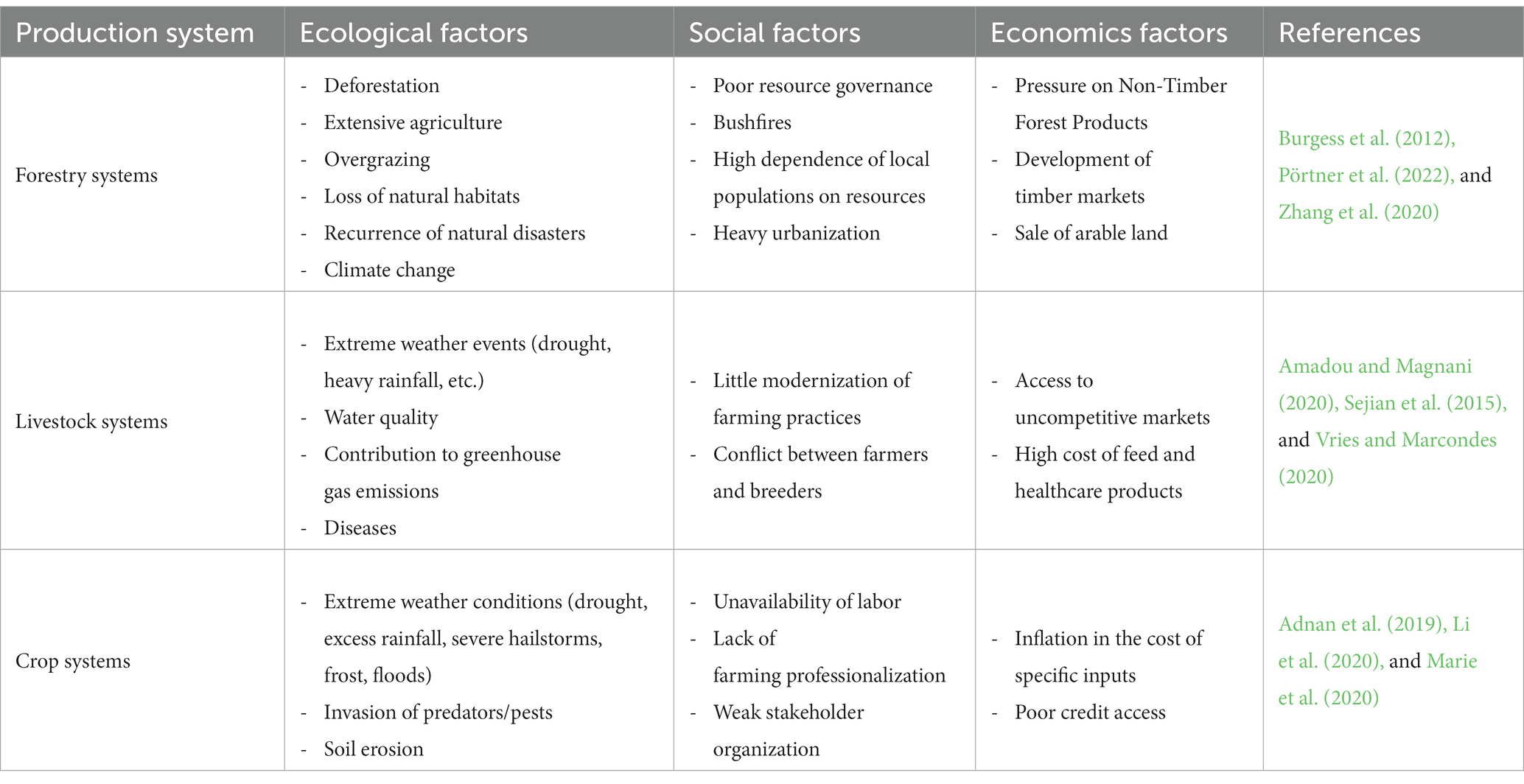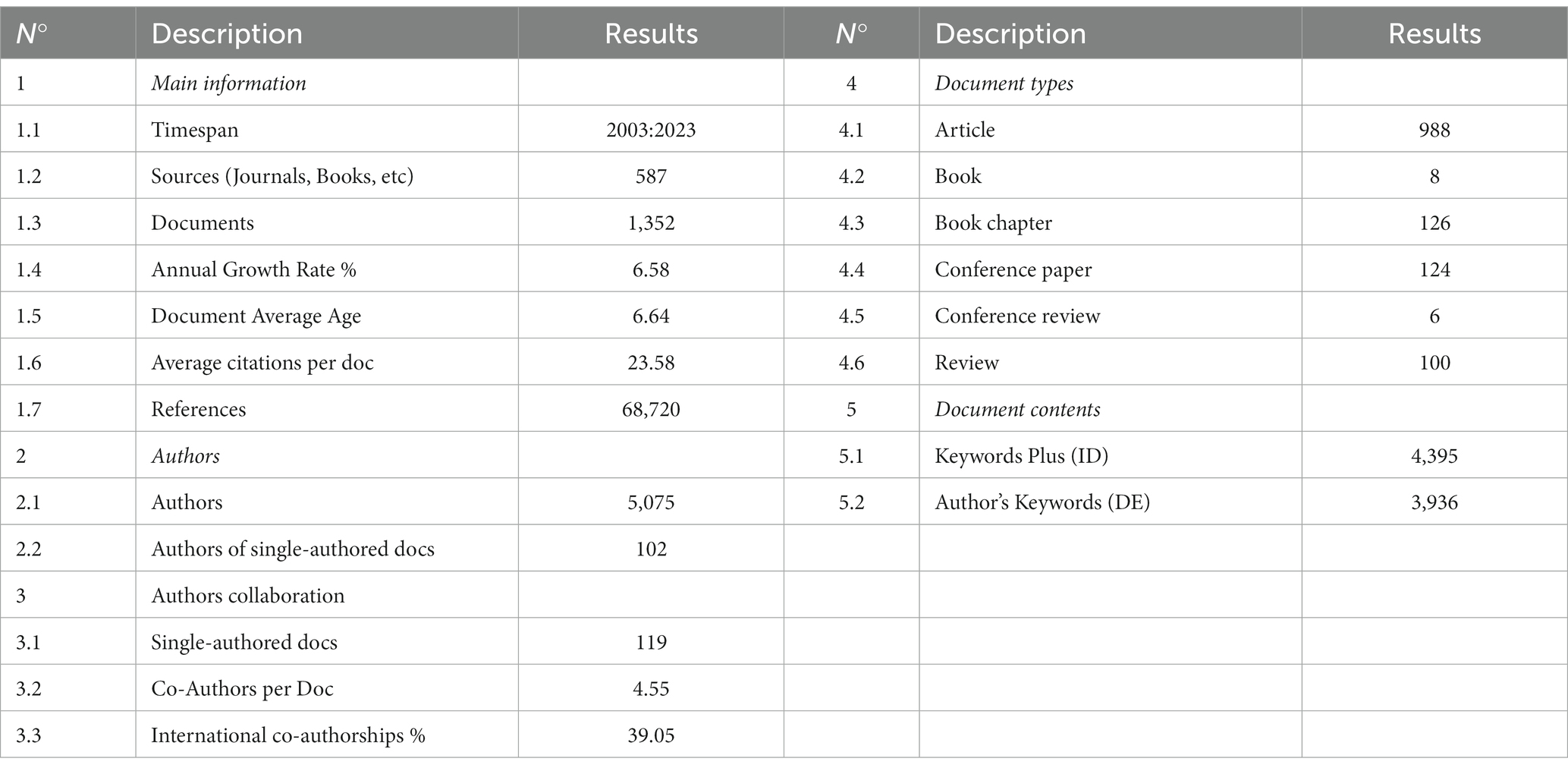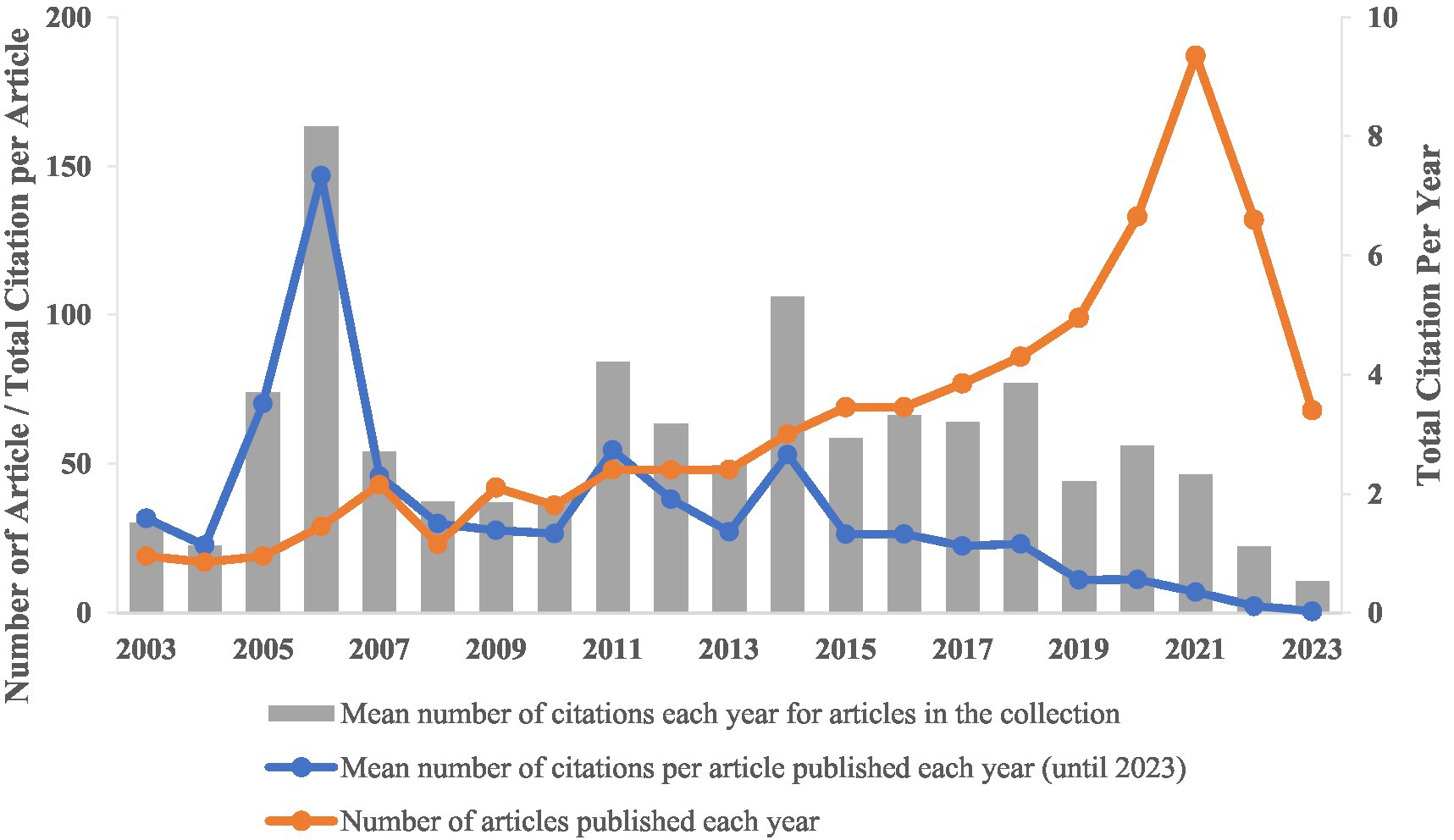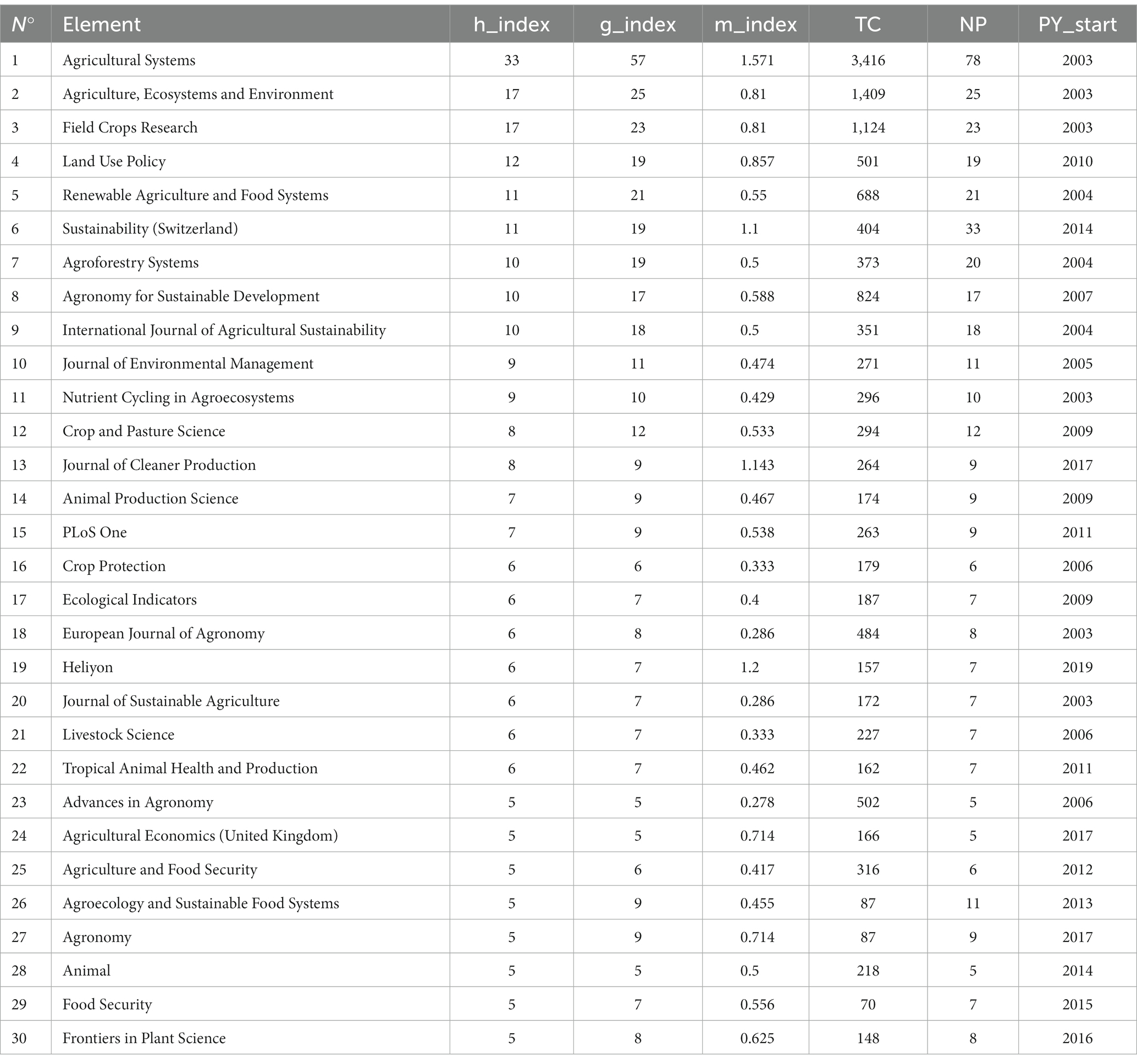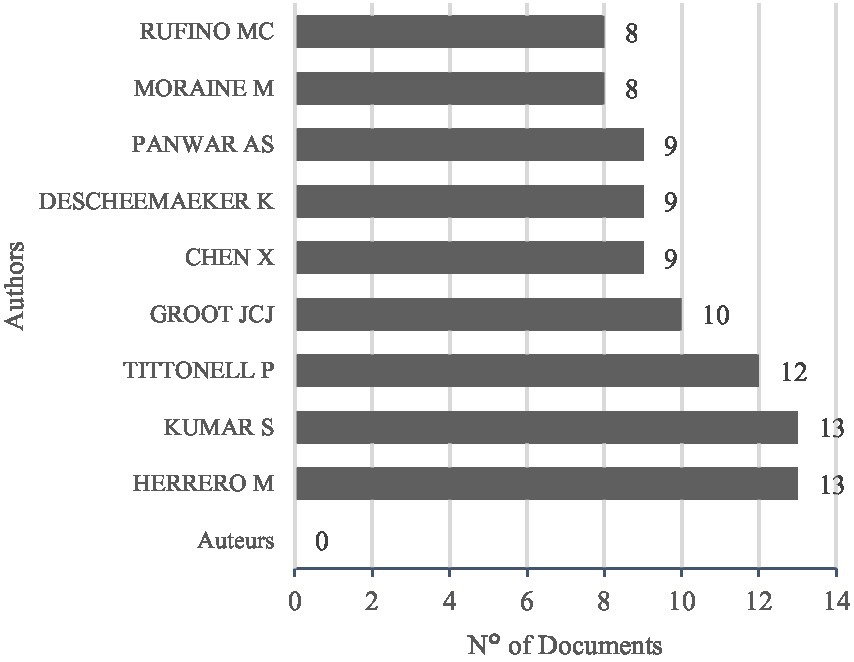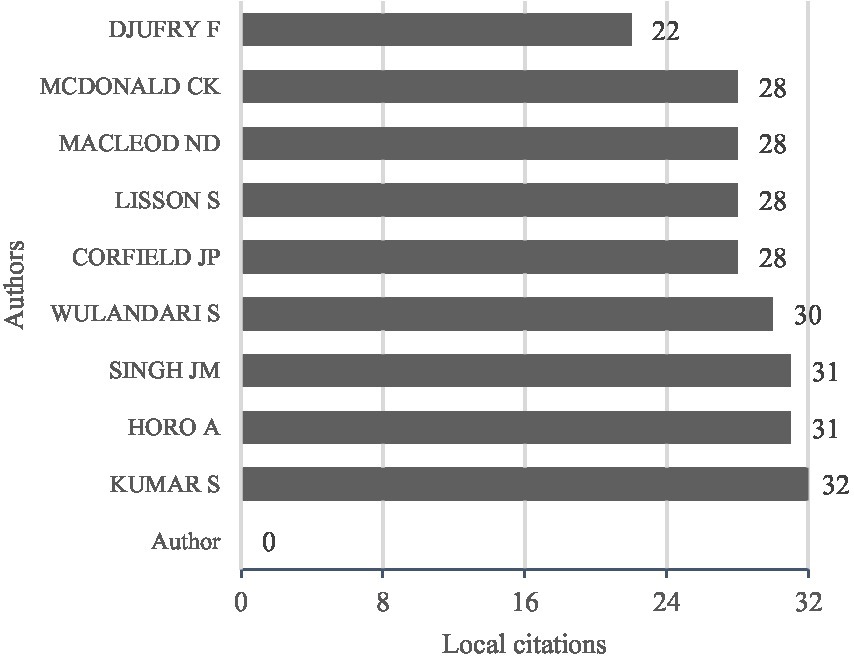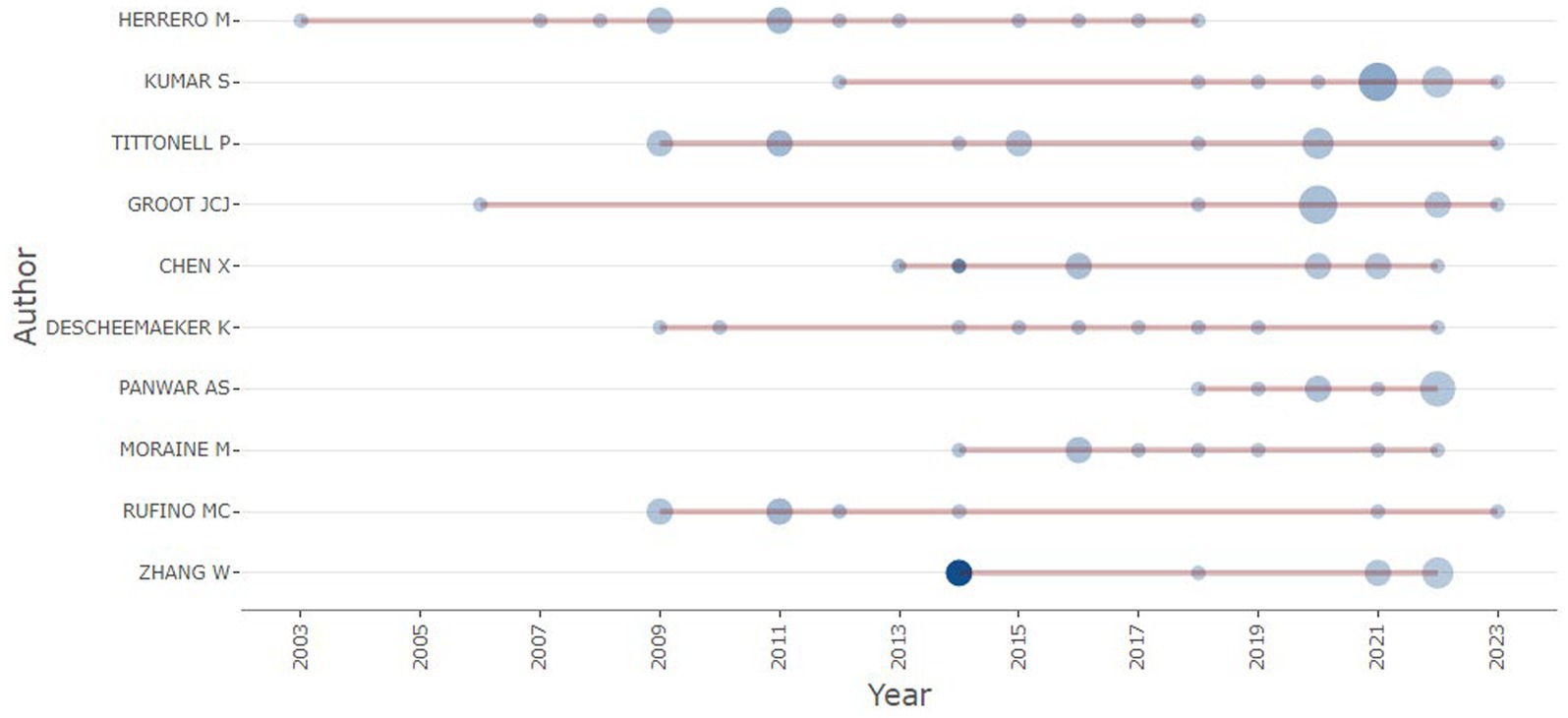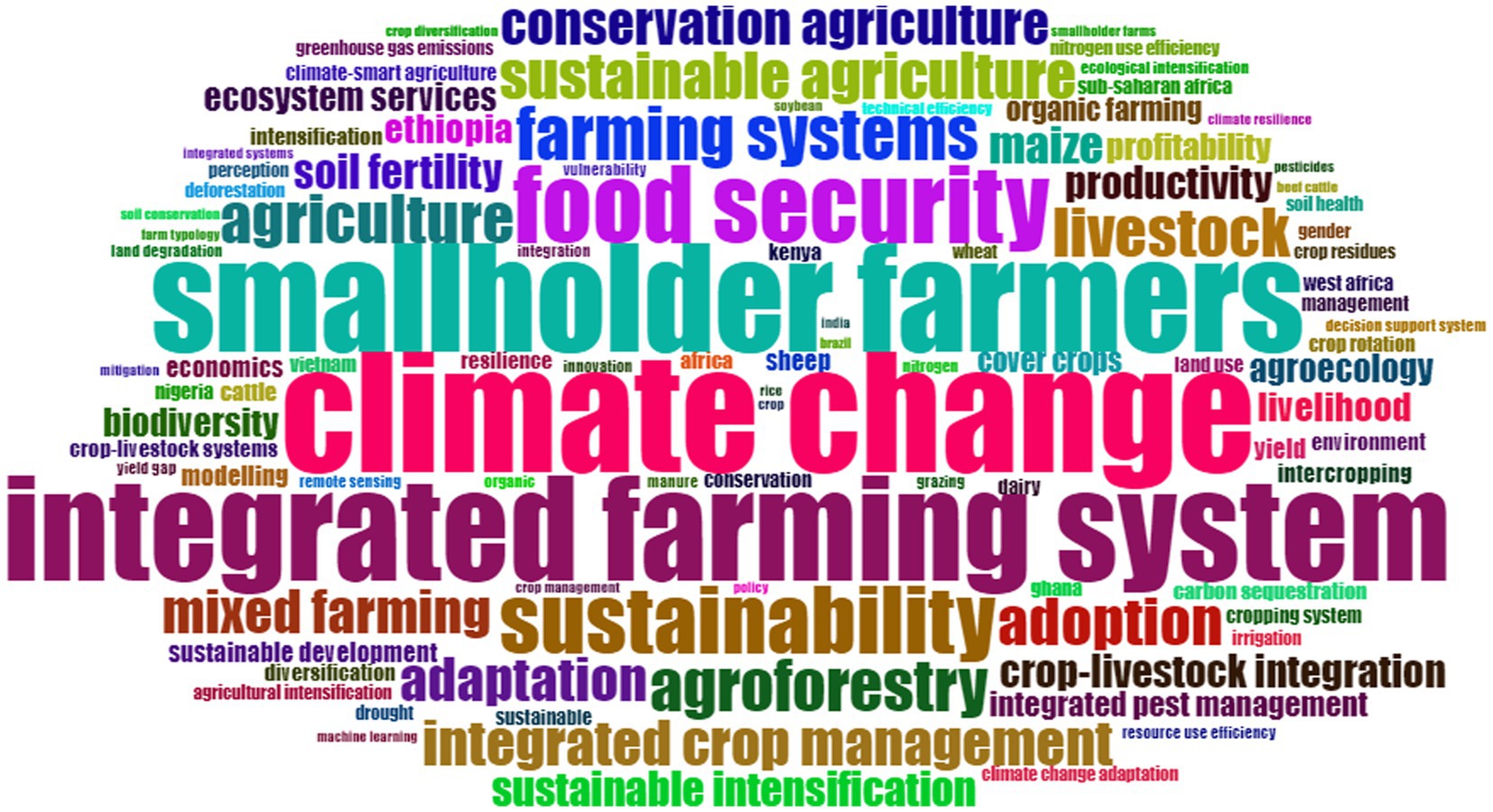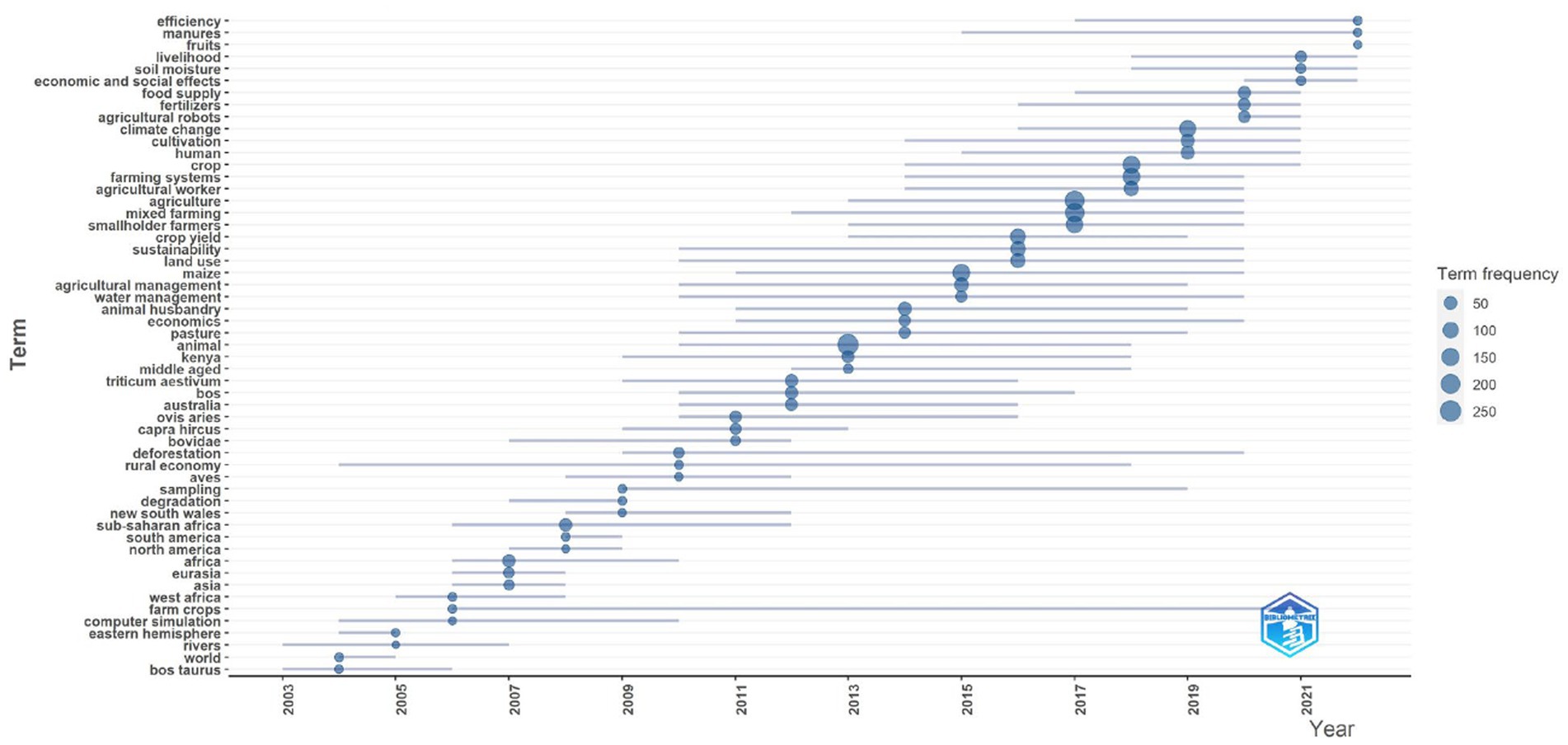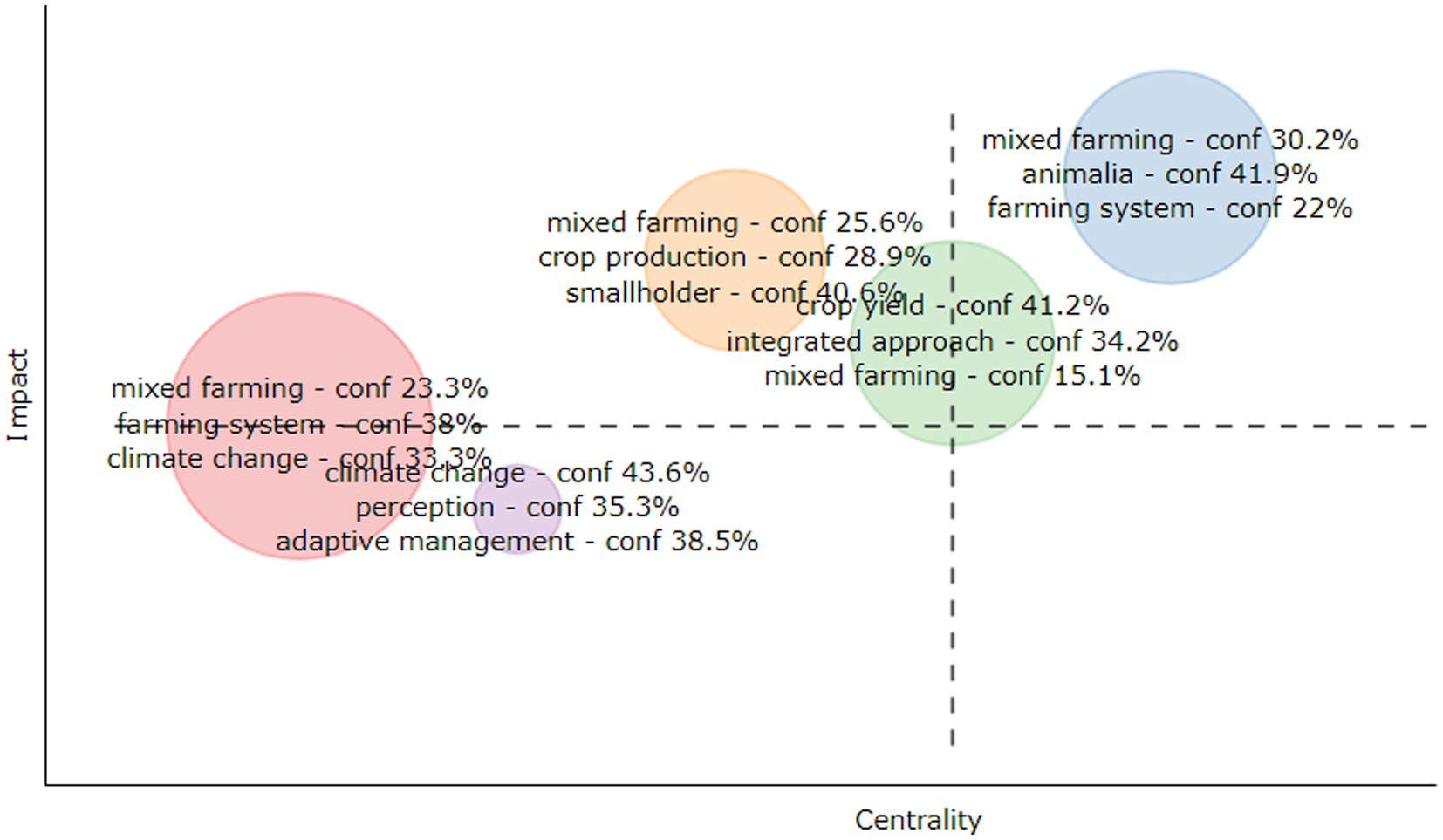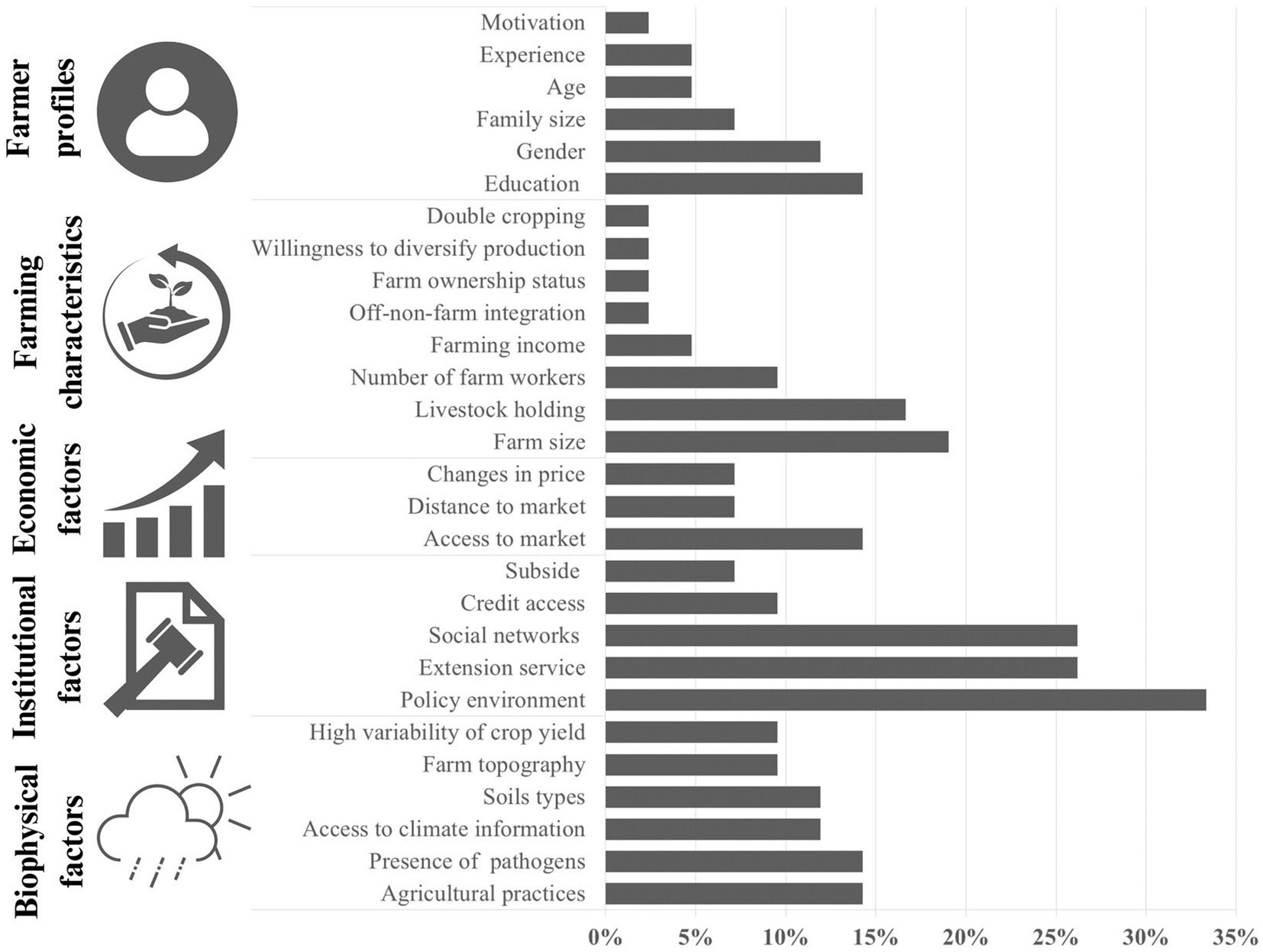Understanding the drivers of rural household scaling up of integrated crop-livestock-forestry systems. A systematic review and bibliometric analysis
- Laboratoire Société-Environnement (LaSEn), Faculté d’Agronomie, Université de Parakou, Parakou, Benin
This literature review focuses on the drivers of Integrated Crop-Livestock-Forestry Systems (ICLFS) adoption by small farmers. It has enabled us to identify current trends and analyze the various drivers of adoption and knowledge gaps. According to the PRISMA literature review protocol, 1,352 scientific publications have been selected and analyzed after a Scopus database search. Data analysis was carried out in two steps. A systematic review was performed with the metadata of scientific publications using the Biblioshiny package of R 4.3.1 software. Then, the 42 most relevant publications were used for a brief narrative synthesis. The results showed that between 2003 and 2023, publications were made in 587 different sources. 73% of publications were scientific articles. 91% of publications were written by an average of 05 co-authors. The effectiveness of Integrated Crop-Livestock-Forestry Systems (ICLFS) practices, the production of organic matter and the effects on farmers’ livelihoods are the research topics considered. Five categories of factors were identified to facilitate the adoption of ICLFS by small farmers: (i) farmer profile, (ii) farm characteristics, (iii) economic factors, (iv) institutional factors and (v) biophysical factors. Policy orientations are the most decisive of all the factors identified, followed by the establishment of extension systems and social networks between farmers. This paper makes three main recommendations. Firstly, it recommends the implementation of collaborative research frameworks between West African researchers and those from East Africa, Asia and South America, who have more experience in this area. In addition, this study suggests that future research on the adoption of ICLFS should take into account herd mobility issues in the adoption process. Finally, it suggests that ICLFS should be taken into account in development policies and implemented through action research projects, mostly in West Africa.
Introduction
Challenges around food security are growing ever more urgent for humanity. According to Global Report on Food Crises 2023, which draws upon data from 58 countries/territories, more than a quarter of people were affected by extreme food insecurity in 2022 (FSIN and GNAFC, 2023). Farming systems are under enormous constraints due to their inability to satisfy food needs of the world’s population. Technological advances, the use of genetic improvements, fertilizers and heavy mechanization have more destroyed the environment and human health than satisfy food needs (Ramankutty et al., 2018; Willett et al., 2019). An alarming observation made by Borrelli et al. (2017) is that this form of agricultural intensification has contributed to the depletion of land nutrients. Indeed, several environmental, social and economic factors explain this fear of the adaptability of crop, forestry and livestock systems to satisfy food needs (Pörtner et al., 2022). As well as the various factors listed in Table 1, production systems are also exposed to the impacts of COVID 19 and the world’s wars (Béné, 2020; Nasir et al., 2022).
In order to address this crisis, many scientists agree that we need to reinvent production systems by promoting agroecological systems (Kremsa, 2021; Côte et al., 2022). One of the promoted agroecological approaches is the Integrated Crop-Livestock-Forestry Systems (ICLFS). ICLFS is an integrated approach that provides options for the sustainable production of goods and services (Matos et al., 2022). This farming system, also referred to as the Mixed Farming and Agroforestry System (MIFAS), is described by Martin et al. (2016) as an integration of farming and agroforestry operations that promotes the creation of opportunities for synergistic resource transfers in time and space. Its main focus is the sustainability of production systems by integrating the scientific concepts of the disciplines of agriculture, ecology, sociology and economy (Moraine et al., 2016; Wezel et al., 2020).
Many authors have studied the socio-economic and environmental benefits of ICLFS. Research carried by Low et al. (2023) in the developed economies of Europe, North America, Australia and East Asia has shown that ICLFS can potentially reduce supply chains through the trading, processing and sale of ICLFS-derived (by)products and enable farmers increase profitability. Other research focused on improving soil quality with the implementation of ICLFS (Valani et al., 2021; Rodrigues et al., 2023). However, the various reviews give little consideration to the factors driving the adoption of ICLS on small farms. This review examines the state of the art in scaling up ICLFS to the smallholder farming. Three research questions are addressed in this paper: (i) What is known about research on smallholder adoption of the ICLFS? (ii) What are the knowledge gaps and the trends in research on the adoption of ICLFS by smallholders? (iii) What are the drivers for the adoption of ICLFS by smallholders?
Adoption of sustainable farming systems
Farming systems refer to the combination of productive activities and their production resources (Grantham et al., 1998). In 2001, the FAO and the World Bank define farming systems as a presentation of the way farmers think and decide. These definitions show that farming systems bring together all the production factors (land, labor, capital) used to make a crop and/or animal production specific to a farm.
Farming systems were soon confronted with the issue of sustainability, with the emergence of several types of system. Sustainable agriculture refers to “a range of strategies for addressing many problems that effect agriculture. Such problems include loss of soil productivity from excessive soil erosion and associated plant nutrient losses, surface and ground water pollution from pesticides, fertilizers and sediments, impending shortages of non- renewable resources, and low farm income from depressed commodity prices and high production costs. Furthermore, “Sustainable” implies a time dimension and the capacity of a farming system to endure indefinitely. “(Rao et al., 2010, p. 9). In other words, sustainable production systems involve integrating the environmental, social and economic dimensions of sustainable development, as defined at the 1992 Rio de Janeiro conference, into farming systems. In the implementation of sustainability strategies for agricultural systems, the promotion of agroecological practices such as ICLFS holds a key place (Gil et al., 2016).
Many authors provide insights into the adoption of agricultural innovation systems. While Rogers (1962) views adoption as a process of “acceptance” of a product, an idea, etc., by an entity within a given social system, Robertson (1971) expands on this concept, stressing that adoption is not a trial, but a commitment to the further use of a product. In 2015, Beaudry defines adoption as the behavior of an agent (an individual) who decides to adopt a technology or innovation at a specific point in time. The adoption of a new practice by farmers depends on several factors. Curry et al. (2021) identified some factors such as gender, experiences in agriculture and others factors.
Methodology
To meet the study’s objectives, a review of scientific publications addressing the drivers of ICLFS adoption by smallholders was conducted. The PRISMA protocol1 conceptualized by Moher et al. (2015) was used to select scientific publications that discuss ICLFS adoption. The methodology adopted can be summarized around three important points (Figure 1): Search, Selection and data analysis. Methodological steps are described below:
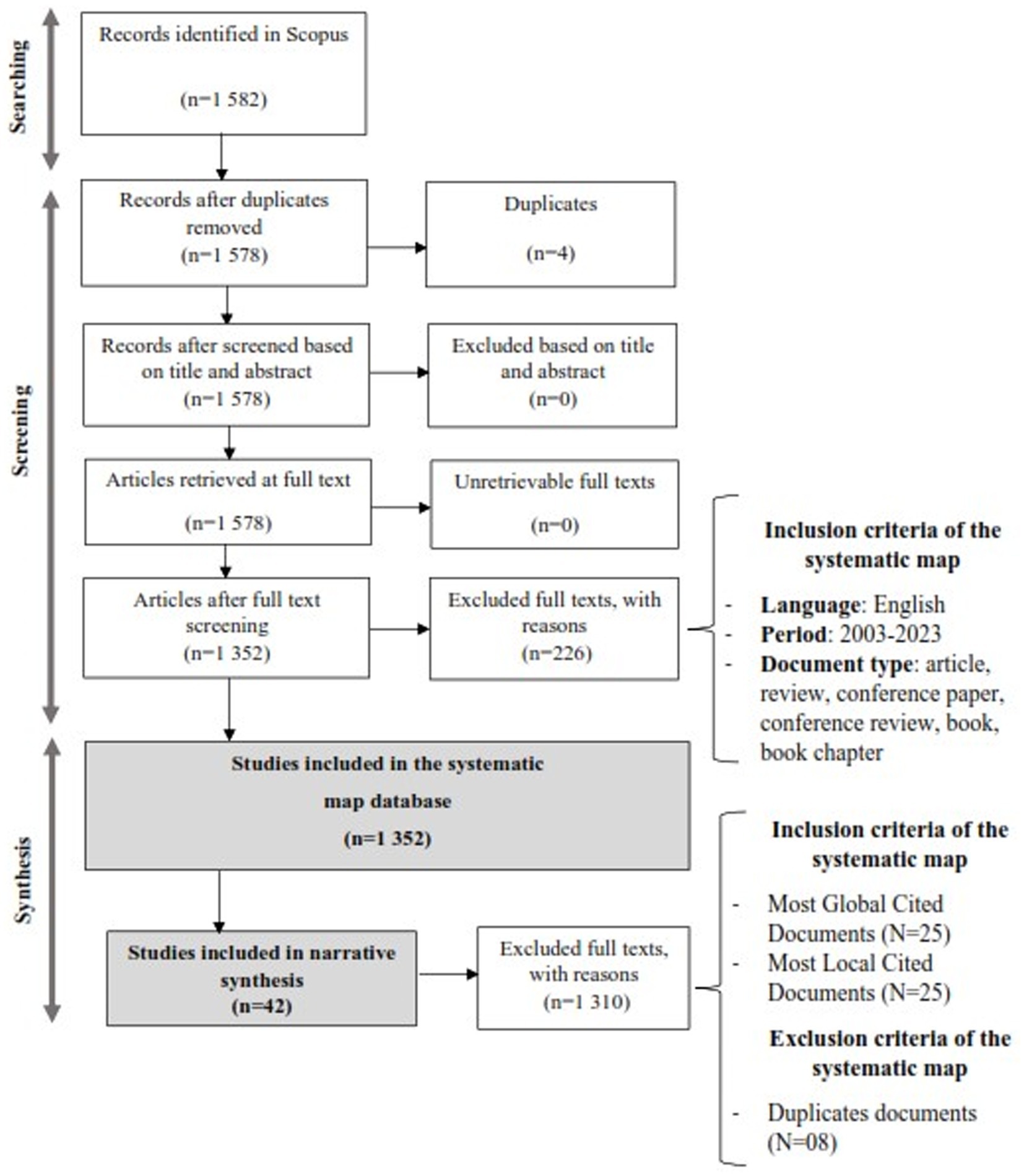
Figure 1. Schematic overview of the method used to the literature review, According to PRISMA guidelines.
Search
The literature search was carried out on the Scopus citation database, which is one of the most extensive databases of scientific citations and references (Singh et al., 2021). Publications were considered up until July 07, 2023. Using the various English keywords identified, search equations were drawn up. The search equation used is as follows:
Once this search had been completed, 1,582 scientific publications were recorded and submitted for screening. The database was not updated after this stage.
Screening of publications
The first step of the screening process consists in removing duplicates. Following this phase, a relevance analysis was carried out based on the titles and abstracts of the scientific publications identified, and then a check was carried out to ensure that all articles were retrievable. The scientific publications identified were subjected to previously established inclusion criteria. These inclusion criteria are that the publications (1) focus on an initiative to scale up an ICLFS, (2) must be published in English, (3) are published between 2003 and 2023 and (4) are articles, reviews, conference papers, conference reviews, books or book chapters. The choice to consider articles in English is justified by the fact that most of the resources on the topic are in English. After this rigorous screening process, 1,353 documents were selected for the data analysis phase. Metadata were exported in BibTeX and csv formats. The exported metadata includes:
- Citation information (authors, document title, year, source title, volume, issue, page, number of citations, source and document title, publication stage, DOI)
- Bibliographic information (affiliations, series identifiers, publishers, source short title)
- Abstract and keywords (abstract, author’s keywords, index keywords)
- Funding details (sponsor, funding text)
- Other information (Include references)
Data analysis
The extracted metadata were then analyzed in two separate steps. Bibliometric analysis was performed using R 4.3.1 software. The Bibliometrix package and the Biblioshiny web interface were used for the performed analyses (Aria and Cuccurullo, 2017). To review the state of the art on knowledge linked to the ICFLS adoption, several analyses were carried out. After a brief description of data collection, an analysis of the evolution of publications over time was carried out. The analysis took three key parameters into account: the number of scientific publications per year, the total number of citations per article and the total number of citations per year. The average number of citations per article is assessed by aggregating the cumulative count of occurrences where the articles of an author, or related to a specific theme, have been cited. This total is then divided by the total number of written articles, providing an indication of the average level of citations attributed to each publication. Concurrently, the average number of citations per year is determined by dividing the total number of citations by the number of years during which the authors have published in the field. This measure proves particularly valuable for assessing the annual impact of research on a theme, thus offering an enlightened perspective on the evolution of their influence over time. The number of articles provides information on the quantity of publications in the collection for each year (Moral-Muñoz et al., 2020).
Publication sources were examined using statistics on the 30 most influential sources in the collection and the 10 most influential sources cited locally. Local citation measures the number of citations a document receives from other articles within the collection, contrasting with global citation that counts citations an article in the collection receives from all publications indexed in the source (Batista-Canino et al., 2023). To assess the contribution of authors to the evolution of research topics, further analyses were carried out. Trends on the top 10 most important authors and top 10 most locally cited authors were generated. This analysis was complemented by an overview of publication trends for the top 10 authors over the last 20 years (Waltman, 2016). Keyword analysis was carried out through word cloud and Trends topics evolution. The literature confirms that analyzing the evolution of topics enables us to understand changes in topics over time and to identify topical and most relevant search themes (Glänzel and Thijs, 2012). A word cloud was created from the 100 keywords most frequently used by authors in the collection. The occurrence of keywords is assessed by their thickness. The most frequently used words are thicker, while the least frequent are thinner. In addition, keywords such as article, which have no impact on the topic, have been eliminated. Synonyms were also merged (e.g.: smallholder farmers, smallholder, smallholders). The thematic evolution was plotted in a graph that shows the evolution of keywords and the frequency of their use through time. The above analyses were complemented by a Bibliographic Coupling Analysis (BCA) to provide a more in-depth analysis of current research areas in the adoption of ICLFS. The BCA was developed by Kessler (1963) for the purpose of comparative analysis of references cited in a collection of scientific publications. It is based on the assumption that if two documents cite the same literature, they cover the same research topics, perspectives and positioning (Maucuer and Renaud, 2019).
The second stage of data analysis was the narrative synthesis, which identified the levers for scaling up ICLFS among smallholders. This analysis took into account the 25 Most Global Cited Documents and the 25 Most Local Cited Documents (Abiola et al., 2023). After removing duplicates (08), 42 publications were submitted to the narrative analysis to determine the drivers of ICLFS adoption by smallholders. The 42 publications were scanned to highlight ICLFS adoption factors. Descriptive statistics were used to determine the occurrence of the different factors in the chosen publications.
Results and discussions
Descriptive overview of the literature review
The Table 2 shows an overview of the research carried out on the ICLFS adoption by smallholders. Over a 20-year period from 2003 to 2023, 1,352 scientific works have been published in 587 different sources. The number of documents cited by the scientific publications identified is equal to 68,720 references. Publications are cited an average of about 23.58 times. These statistics show that the information contained in these documents is of great interest for the scientific research. During the 20 years covered by this review, 5,075 authors have published on the thematic. Nine out of 10 papers (91.20%) were co-authored by an average of 05 authors (4.55) per document. Collaboration between authors at international level is estimated at 39%. Regarding document type, around three-quarters of published scientific documents (73%) are articles, 9.32% are book chapters and 7.40% are journal articles. The summary keyword analysis shows a high degree of consistency between the keywords used by the authors and those generated automatically based on references. Four hundred and fifty-nine additional keywords were detected in the references compared with the keywords generated from the data collections. The keywords used by the authors reflect and are more informative about trends in ICLFS research.
Scientific publication trends
An analysis of the evolution of publications over time has been carried out and is presented in Figure 2. It shows the evolution of parameters such as the number of articles published per year, the average number of total citations per article and the average number of total citations per year. Overall, the trend in publications on the ICFLS adoption has two important periods. There is an ascending phase from 2003 to 2021, with 1,152 publications, and a descending phase from 2021 to 2023. During the latter phase, 200 articles were published. The upward phase of publications took place during the period of the United Nations Decade for Biodiversity from 2011 to 2020 when the Integrated Resource Management Strategy was adopted for the implementation of the Convention on Biological Diversity (UNEP, 2012). The drop in research spending over last 2 years (2021–2023) can be attributed to a stabilization in thematic research. In 2021, the number of publications peaked at an estimated 187. This coincides with the 2nd World Congress on Integrated Crop-Livestock-Forestry Systems. Variations in the average number of citations per year and per article show a decrease in the number of citations per article and per year from 2014 onwards. However, in 2006, the increase in the number of citations per year (8.16) matched the number of citations per article (146.83), with a total of 29 scientific publications.
Sources of research publications
Table 3 shows the top 30 most influential sources of publications concerned with scaling up ICLFS in rural households. The parameters presented in the table are the H-index, the G-index, the M-index, the total number of citations and the number of publications. The scientific publications were made in 468 different sources. This table shows that 20% of publication sources began publishing in 2003. Throughout the entire period, 2003 saw the greatest number of scientific publications. These results provide further evidence that 2003 was a key year in the development of ICLFS research. FAO put in place political strategies and institutional measures in 2003, which were incorporated into national plans, to ensure that farming systems were adaptable to food needs through the promotion of integrated farming systems (FAO, 2004). The analyses also showed the 10 most cited sources locally (Figure 3). “Agricultural Systems and Agriculture” and “Ecosystems & Environment” are the most cited sources, with, respectively, 737 and 596 local citations.
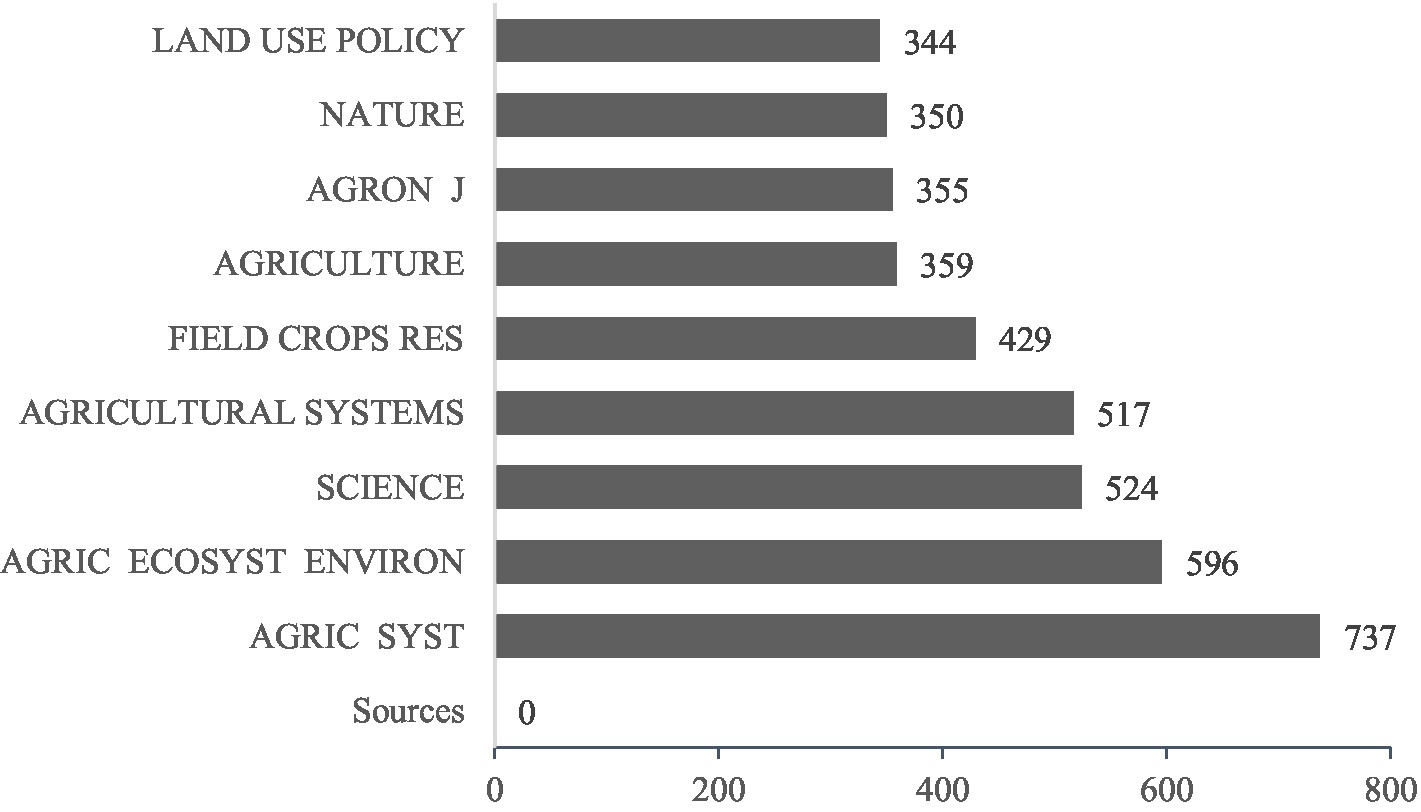
Figure 3. Top 10 of most locally cited sources on integrated crop-livestock-forest systems adoption.
Most impactful authors
Figure 4 shows the top 10 authors with the most publications. It provides an index of the authors’ productivity. Analysis of this figure shows that Kumar S. and Herrero M. have each published 13 scientific articles. Three authors have the same number of scientific publications (08). These authors are Zhang W., Rufino MC. and Moraine M. The top 10 authors with the most local citations are shown in Figure 5. Kumar S. has 32 local citations, followed by Singh JM. and Horo A. with 31 local citations each. Closing the ranking is Paramesh V. with 20 local citations. Figure 6 provides some details on the scientific production per year. By author, it gives the number of articles and citations per year. The size of the bulbs provides information on the number of publications, while the intensity of the bulb color provides information on the number of citations per year. The results show that Kumar S. has published the most publications and is also the most cited author on the subject. It should be noted that these indicators only measure the activity of different researchers on the topic and provide limited information about their actual impact.
Keywords’ analysis and trends topics
Figure 7 shows the cloud of the 100 keywords most used by the authors. According to the frequencies of occurrence of key words in the word cloud, ICLFS studies are gradually being integrated into smallholder farmers’ climate change adaptation strategies. Food security and the sustainability of farming systems are also among the topics addressed. However, ICLFS adoption in African countries has received little attention. Also, women’s contribution to the scaling-up of ICLFS is little explored. The trends in ICLFS research presented in Figure 8 show the emergence of new research topics. Over the past 2 years, research has focused on ICFLS efficiency, manure production, fruit production, livelihoods and the socio-economic effects of ICFLS. This trend in research is sufficient proof of the importance of scaling up ICLFS with farmers. These studies will provide theoretical evidence to facilitate the adoption process.
Bibliometric coupling of documents
A scientific map was drawn up to determine the impact of scientific publications and the linkages between documents. The documents represent the unit of analysis. The analysis was based on the 250 most influential publications in the collection, representing 18.49% of all publications. Minimum frequency of grouped links was measured at around 10%. Taking impact and centrality into account, five clusters were identified. These clusters are presented below (the color within brackets indicate the color of the cluster in Figure 9):
1. Mixed farming practices in farmers’ adaptation to climate change (pink): located between the upper left and lower left quarters, this cluster is characterized by a centrality of 0.33 with an impact of 1.95. It includes 84 documents. The topic addressed in the cluster is related to the use of mixed farming practices in farmers’ adaptation to climate change. Behera and France’s (2016) paper makes a strong contribution to the topic with 5.23 normalized local citations. This paper was followed by Asante et al. (2018) with 2.99 local normalized citations and Takahashi et al. (2020) with 2.7 local normalized citations.
2. Relationship between integrated systems and livestock farming (Blue): This cluster is characterized by a centrality of 0.535, an impact of 4.64 and 54 documents. It is located in the upper right-hand quadrant and mainly addresses the relationship between integrated systems and livestock farming. Bell and Moore’s (2012) article is the most influential document in this cluster with a score of 13.44 normalized local citations. It is followed by the articles written by Russelle et al. (2007) and Martin et al. (2016), which have a score of 13.33 and 11.5 local normalized citations, respectively.
3. Crop yields in relation to integrated practice (Green): the third cluster is positioned at the center of the graph and focuses on crop yields in relation to integrated practice. With 50 documents, this cluster has a centrality of 0.41 and an estimated impact of 2.45. The three papers that contribute strongly to this cluster are those by Gil et al. (2015, 2016) and Chen et al. (2011). These papers have a normalized local citation score of 6.61, 5.75 and 5.29, respectively.
4. Climate change perceptions and adaptation strategies (Orange): This focuses on perceptions and adaptation strategies around climate change issues. 19 publications were identified in this cluster, with a centrality of 0.33 and an impact of 1.16. The most influential article in this cluster is by Kgosikoma et al. (2018) with a local normalized citation of 1.5. Gebre et al. (2023) and Jena et al. (2023) each have one normalized local citation. It is located in the top left-hand quadrant.
5. Agricultural production with mixed farming practices (Purple): This cluster is located in the lower left-hand quadrant and comprises 41 documents. It has a centrality of 0.37 and an impact of 3.26. The publication of Valbuena et al. (2015) is the most influenced in the network with 8.16 normalized local citations. It is followed by the publication of Rufino et al. (2011) with a normalized local citation score of 5.29 and that by Giller et al. (2011) which has 4.88 normalized local citations. This cluster focuses on agricultural production by small farmers based on mixed farming practices.
ICLS adoption drivers based on literature review
The analysis of ICLFS adoption drivers was based on the 42 scientific publications identified after the selection process. Several factors affect the adoption of ICLFS by farmers. On the basis of the literature, a number of factors have been identified (Figure 10). Five categories of factors were distinguished. These are factors linked to the farmer’s profile, farm characteristics, economic factors, institutional factors and biophysical factors. An analysis of the results shows the key role of institutional factors in the ICLFS adoption process. The implementation of environmental policies that encourage the development and scaling-up of ICLFS appears to be the most important factor. Indeed, Garrett et al. (2017) and Asai et al. (2018) argue that environmental policy orientations must accompany the ICLFS adoption process. This factor is followed by others such as access to extension services and the establishment of stakeholder networks for the dissemination of ICLFS practices (Behera and France, 2016; Tesema, 2021). Access to credit or subsidies is a significant contributing factor in promoting also the adoption of policies that favor the ICLFS (Devendra, 2007; Mariano et al., 2012; Moraine et al., 2017). Other market-related economic factors have been highlighted by Lal et al. (2007), Udo et al. (2011), and Tesema (2021), and many other authors. Biophysical factors such as experience with farming practices (Bolliger et al., 2006), the presence of pathogens (Oerke, 2006), soil type (Lisson et al., 2010), access to climatic information (Mzoughi, 2011), topography (Gil et al., 2016) and variability of crop yields (De Moraes et al., 2014) also determine the ICLFS adoption. Other factors linked to the farmer and his/her farm also explain the ICLFS adoption. Indeed, the size of the farm and livestock held, level of education, gender, income level, availability of labor, age… are factors that influence the ICLFS adoption. For example, Widadie and Agustono’s (2015) research showed that education level, income as well as family size positively influence farmers’ adoption of agriculture-livestock integration technologies. Tesema (2021) proved that age, gender, farm size and herd size affect the ICLFS adoption.
Knowledge gaps and orientations for future research
This study has provided an understanding of research trends related to the adoption of ICLFS by smallholders. Among the key findings was the paucity of data on ICLFS scaling-up initiatives in Sub-Saharan Africa. Given the urgent need to adapt to climate change, adaptation options such as ICLFS need to be scaled up and reported in this area to ensure the sustainability of food production. Although livestock holding parameters are major indicators for the adoption of ICLFS, it is vital that future thinking integrates livestock rearing methods into the scaling-up of these practices. For example, we need to consider how to scale up ICFLS in a context characterized by high herd mobility. Finally, politicians need to take ownership of ICLFS in order to provide technical and financial support for their implementation. It would be very interesting for countries promoting reduced livestock mobility to think about developing more policies along these lines, not only to encourage communities to live together, but also to develop safe alternatives for sustainable land management and food production. Given research experience in East Africa, Asia and South America, research and experience-sharing partnerships with West African regions would be highly beneficial for promoting ICLFS and advancing toward SDGs 1, 2, 5, 13, and 15.
Conclusion
ICLFS is a sustainable way of producing food that will help reduce the harm caused by climate change and meet the needs of people. This research emphasizes that the crucial element in achieving sustainable food production is the establishment of clear, effective environmental policies that promote the integration of different systems. These green policies must be supported by practical and financial actions for expansion, connecting farmers and funding farming activities. Nations such as Benin, which promote stationary livestock farming through its law, should try out this method. Last but not least, this study promotes research cooperation on this issue, especially to help West African countries. Future studies should focus on how to design agro-forestry-pastoral innovations together with development actors and producers, so that they can be more easily adopted by rural communities.
Author contributions
MK: Conceptualization, Methodology, Writing – original draft, Investigation. JE: Conceptualization, Methodology, Writing – review & editing. SD: Writing – review & editing. MB: Supervision, Writing – review & editing.
Funding
The author(s) declare that no financial support was received for the research, authorship, and/or publication of this article.
Conflict of interest
The authors declare that the research was conducted in the absence of any commercial or financial relationships that could be construed as a potential conflict of interest.
Publisher’s note
All claims expressed in this article are solely those of the authors and do not necessarily represent those of their affiliated organizations, or those of the publisher, the editors and the reviewers. Any product that may be evaluated in this article, or claim that may be made by its manufacturer, is not guaranteed or endorsed by the publisher.
Footnotes
References
Abiola, W. A., Diogo, R. V. C., Tovihoudji, P. G., Mien, A. K., and Schalla, A. (2023). Research trends on biochar-based smart fertilizers as an option for the sustainable agricultural land management: bibliometric analysis and review. Front. Soil Sci. 3:1136327. doi: 10.3389/fsoil.2023.1136327
Adnan, N., Nordin, S. M., Bahruddin, M. A., and Tareq, A. H. (2019). A state-of-the-art review on facilitating sustainable agriculture through green fertilizer technology adoption: assessing farmers behavior. Trends Food Sci. Technol. 86, 439–452. doi: 10.1016/j.tifs.2019.02.040
Amadou, H., and Magnani, S. D. (2020). Améliorer l’accès des éleveurs à une alimentation du bétail de qualité pour augmenter la production laitière dans les Pays sahéliens d’Afrique de l’Ouest, No. 21.
Aria, M., and Cuccurullo, C. (2017). Bibliometrix: an R-tool for comprehensive science mapping analysis. J. Informet. 11, 959–975. doi: 10.1016/j.joi.2017.08.007
Asai, M., Moraine, M., Ryschawy, J., De Wit, J., Hoshide, A. K., and Martin, G. (2018). Critical factors for crop-livestock integration beyond the farm level: a cross-analysis of worldwide case studies. Land Use Policy 73, 184–194. doi: 10.1016/j.landusepol.2017.12.010
Asante, B. O., Villano, R. A., Patrick, I. W., and Battese, G. E. (2018). Determinants of farm diversification in integrated crop–livestock farming systems in Ghana. Renew. Agric. Food Syst. 33, 131–149. doi: 10.1017/S1742170516000545
Batista-Canino, R. M., Santana-Hernández, L., and Medina-Brito, P. (2023). A scientometric analysis on entrepreneurial intention literature: delving deeper into local citation. Heliyon 9:e13046. doi: 10.1016/j.heliyon.2023.e13046
Behera, U. K., and France, J. (2016). Integrated farming systems and the livelihood security of small and marginal farmers in India and other developing countries. Adv. Agron. 138, 235–282. doi: 10.1016/bs.agron.2016.04.001
Bell, L. W., and Moore, A. D. (2012). Integrated crop–livestock systems in Australian agriculture: trends, drivers and implications. Agric. Syst. 111, 1–12. doi: 10.1016/j.agsy.2012.04.003
Béné, C. (2020). Resilience of local food systems and links to food security – a review of some important concepts in the context of COVID-19 and other shocks. Food Secur. 12, 805–822. doi: 10.1007/s12571-020-01076-1
Bolliger, A., Magid, J., Amado, J. C. T., Skóra Neto, F., Ribeiro, M. D. F. D. S., Calegari, A., et al. (2006). Taking stock of the Brazilian “zero-till revolution”: a review of landmark research and farmers’ practice. Adv. Agron. 91, 47–110. doi: 10.1016/S0065-2113(06)91002-5
Borrelli, P., Robinson, D. A., Fleischer, L. R., Lugato, E., Ballabio, C., Alewell, C., et al. (2017). An assessment of the global impact of 21st century land use change on soil erosion. Nat. Commun. 8:2013. doi: 10.1038/s41467-017-02142-7
Burgess, R., Hansen, M., Olken, B. A., Potapov, P., and Sieber, S. (2012). The political economy of deforestation in the tropics. Q. J. Econ. 127, 1707–1754. doi: 10.1093/qje/qjs034
Chen, X.-P., Cui, Z.-L., Vitousek, P. M., Cassman, K. G., Matson, P. A., Bai, J.-S., et al. (2011). Integrated soil–crop system management for food security. Proc. Natl. Acad. Sci. 108, 6399–6404. doi: 10.1073/pnas.1101419108
Côte, F. X., Rapidel, B., Sourisseau, J. M., Affholder, F., Andrieu, N., Bessou, C., et al. (2022). Levers for the agroecological transition of tropical agriculture. Agron. Sustain. Dev. 42:67. doi: 10.1007/s13593-022-00799-z
Curry, G. N., Nake, S., Koczberski, G., Oswald, M., Rafflegeau, S., Lummani, J., et al. (2021). Disruptive innovation in agriculture: socio-cultural factors in technology adoption in the developing world. J. Rural. Stud. 88, 422–431. doi: 10.1016/j.jrurstud.2021.07.022
De Moraes, A., Carvalho, P. C. D. F., Anghinoni, I., Lustosa, S. B. C., Costa, S. E. V. G. D. A., and Kunrath, T. R. (2014). Integrated crop–livestock systems in the Brazilian subtropics. Eur. J. Agron. 57, 4–9. doi: 10.1016/j.eja.2013.10.004
Devendra, C. (2007). Small farm systems to feed hungry Asia. Outlook Agric. 36, 7–20. doi: 10.5367/000000007780223641
FSIN and GNAFC. (2023). Global report on food crises 2023: Joint analysis for better decisions. FSIN and GNAFC.
Garrett, R. D., Niles, M. T., Gil, J. D. B., Gaudin, A., Chaplin-Kramer, R., Assmann, A., et al. (2017). Social and ecological analysis of commercial integrated crop livestock systems: current knowledge and remaining uncertainty. Agric. Syst. 155, 136–146. doi: 10.1016/j.agsy.2017.05.003
Gebre, G. G., Amekawa, Y., Fikadu, A. A., and Rahut, D. B. (2023). Do climate change adaptation strategies improve farmers’ food security in Tanzania? Food Secur. 15, 629–647. doi: 10.1007/s12571-023-01348-6
Gil, J., Garrett, R., and Berger, T. (2016). Determinants of crop-livestock integration in Brazil: evidence from the household and regional levels. Land Use Policy 59, 557–568. doi: 10.1016/j.landusepol.2016.09.022
Gil, J., Siebold, M., and Berger, T. (2015). Adoption and development of integrated crop–livestock–forestry systems in Mato Grosso, Brazil. Agric. Ecosyst. Environ. 199, 394–406. doi: 10.1016/j.agee.2014.10.008
Giller, K. E., Tittonell, P., Rufino, M. C., Van Wijk, M. T., Zingore, S., Mapfumo, P., et al. (2011). Communicating complexity: integrated assessment of trade-offs concerning soil fertility management within African farming systems to support innovation and development. Agric. Syst. 104, 191–203. doi: 10.1016/j.agsy.2010.07.002
Glänzel, W., and Thijs, B. (2012). Using ‘core documents’ for detecting and labelling new emerging topics. Scientometrics 91, 399–416. doi: 10.1007/s11192-011-0591-7
Grantham, G. W., Postel-Vinay, G., Mazoyer, M., and Roudard, L. (1998). Histoire des agricultures du monde. Du néolithique à la crise contemporaine, 1997. Revue d’Études en Agriculture et Environnement, 48, pp. 129–131.
Jena, P. R., Tanti, P. C., and Maharjan, K. L. (2023). Determinants of adoption of climate resilient practices and their impact on yield and household income. J. Agric. Food Res. 14:100659. doi: 10.1016/j.jafr.2023.100659
Kessler, M. M. (1963). Bibliographic coupling between scientific papers. American Documentation 14, 10–25. doi: 10.1002/asi.5090140103
Kgosikoma, K. R., Lekota, P. C., and Kgosikoma, O. E. (2018). Agro-pastoralists’ determinants of adaptation to climate change. Int. J. Clim. Change Strat. Manage. 10, 488–500. doi: 10.1108/IJCCSM-02-2017-0039
Kremsa, V. Š. (2021). “Sustainable management of agricultural resources (agricultural crops and animals)” in Sustainable Resource Management. eds. C. M. Hussain and J. F. Velasco-Muñoz (Amsterdam, Netherlands: Elsevier), 99–145.
Lal, R., Follett, R. F., Stewart, B. A., and Kimble, J. M. (2007). Soil carbon sequestration to mitigate climate change and advance food security. Soil Sci. 172, 943–956. doi: 10.1097/ss.0b013e31815cc498
Li, M., Wang, J., Zhao, P., Chen, K., and Wu, L. (2020). Factors affecting the willingness of agricultural green production from the perspective of farmers’ perceptions. Sci. Total Environ. 738:140289. doi: 10.1016/j.scitotenv.2020.140289
Lisson, S., MacLeod, N., McDonald, C., Corfield, J., Pengelly, B., Wirajaswadi, L., et al. (2010). A participatory, farming systems approach to improving Bali cattle production in the smallholder crop–livestock systems of eastern Indonesia. Agric. Syst. 103, 486–497. doi: 10.1016/j.agsy.2010.05.002
Low, G., Dalhaus, T., and Meuwissen, M. P. M. (2023). Mixed farming and agroforestry systems: a systematic review on value chain implications. Agric. Syst. 206:103606. doi: 10.1016/j.agsy.2023.103606
Mariano, M. J., Villano, R., and Fleming, E. (2012). Factors influencing farmers’ adoption of modern rice technologies and good management practices in the Philippines. Agric. Syst. 110, 41–53. doi: 10.1016/j.agsy.2012.03.010
Marie, M., Yirga, F., Haile, M., and Tquabo, F. (2020). Farmers’ choices and factors affecting adoption of climate change adaptation strategies: evidence from northwestern Ethiopia. Heliyon 6:e03867. doi: 10.1016/j.heliyon.2020.e03867
Martin, G., Moraine, M., Ryschawy, J., Magne, M.-A., Asai, M., Sarthou, J.-P., et al. (2016). Crop–livestock integration beyond the farm level: a review. Agron. Sustain. Dev. 36:53. doi: 10.1007/s13593-016-0390-x
Matos, A. M. S., Bonini, C. S. B., Moreira, B. R. A., Andreotti, M., Heinrichs, R., Da Silva, D. T., et al. (2022). Long-term integrated crop–livestock–forestry systems recover the structural quality of Ultisol soil. Agronomy 12:2961. doi: 10.3390/agronomy12122961
Maucuer, R., and Renaud, A. (2019). Business model research: a bibliometric analysis of origins and trends. M@n@gement 22:176. doi: 10.3917/mana.222.0176
Moher, D., Shamseer, L., Clarke, M., Ghersi, D., Liberati, A., Petticrew, M., et al. (2015). Preferred reporting items for systematic review and meta-analysis protocols (PRISMA-P) 2015 statement. Syst. Rev. 4:1. doi: 10.1186/2046-4053-4-1
Moraine, M., Duru, M., and Therond, O. (2017). A social-ecological framework for analyzing and designing integrated crop–livestock systems from farm to territory levels. Renew. Agric. Food Syst. 32, 43–56. doi: 10.1017/S1742170515000526
Moraine, M., Grimaldi, J., Murgue, C., Duru, M., and Therond, O. (2016). Co-design and assessment of cropping systems for developing crop-livestock integration at the territory level. Agric. Syst. 147, 87–97. doi: 10.1016/j.agsy.2016.06.002
Moral-Muñoz, J. A., Herrera-Viedma, E., Santisteban-Espejo, A., and Cobo, M. J. (2020). Software tools for conducting bibliometric analysis in science: an up-to-date review. Prof. Inf. 29:3. doi: 10.3145/epi.2020.ene.03
Mzoughi, N. (2011). Farmers adoption of integrated crop protection and organic farming: do moral and social concerns matter? Ecol. Econ. 70, 1536–1545. doi: 10.1016/j.ecolecon.2011.03.016
Nasir, M. A., Nugroho, A. D., and Lakner, Z. (2022). Impact of the Russian–Ukrainian conflict on global food crops. Foods 11:2979. doi: 10.3390/foods11192979
Oerke, E.-C. (2006). Crop losses to pests. J. Agric. Sci. 144, 31–43. doi: 10.1017/S0021859605005708
Pörtner, H. O., Roberts, D. C., Adams, H., Adler, C., Aldunce, P., Ali, E., et al. (2022). Climate change 2022: Impacts, adaptation and vulnerability. Switzerland: IPCC Geneva.
Ramankutty, N., Mehrabi, Z., Waha, K., Jarvis, L., Kremen, C., Herrero, M., et al. (2018). Trends in global agricultural land use: implications for environmental health and food security. Annu. Rev. Plant Biol. 69, 789–815. doi: 10.1146/annurev-arplant-042817-040256
Rao, V. P., Veeraraghavaiah, R., Hemalatha, S., and Joseph, B. (2010). Farming systems and sustainable agriculture. Jodhpur: Agrobios.
Robertson, T. S. (1971). Innovative behavior and communication. Available at: https://cir.nii.ac.jp/crid/1130000794546025088.
Rodrigues, R. A. R., Ferreira, I. G. M., Da Silveira, J. G., Da Silva, J. J. N., Santos, F. M., and Da Conceição, M. C. G. (2023). “Crop-livestock-Forest integration systems as a sustainable production strategy in Brazil” in Sustainability challenges of Brazilian agriculture: Governance, inclusion, and innovation. eds. N. Søndergaard, C. D. de Sá, and A. F. Barros-Platiau (Berlin: Springer International Publishing), 165–182.
Rufino, M. C., Dury, J., Tittonell, P., Van Wijk, M. T., Herrero, M., Zingore, S., et al. (2011). Competing use of organic resources, village-level interactions between farm types and climate variability in a communal area of NE Zimbabwe. Agric. Syst. 104, 175–190. doi: 10.1016/j.agsy.2010.06.001
Russelle, M. P., Entz, M. H., and Franzluebbers, A. J. (2007). Reconsidering integrated crop–livestock Systems in North America. Agron. J. 99, 325–334. doi: 10.2134/agronj2006.0139
Sejian, V., Bhatta, R., Soren, N. M., Malik, P. K., Ravindra, J. P., Prasad, C. S., et al. (2015). “Introduction to concepts of climate change impact on livestock and its adaptation and mitigation” in Climate change impact on livestock: adaptation and mitigation. eds. V. Sejian, J. Gaughan, L. Baumgard, and C. Prasad (Berlin: Springer India), 1–23.
Singh, V. K., Singh, P., Karmakar, M., Leta, J., and Mayr, P. (2021). The journal coverage of web of science, Scopus and dimensions: a comparative analysis. Scientometrics 126, 5113–5142. doi: 10.1007/s11192-021-03948-5
Takahashi, K., Muraoka, R., and Otsuka, K. (2020). Technology adoption, impact, and extension in developing countries’ agriculture: a review of the recent literature. Agric. Econ. 51, 31–45. doi: 10.1111/agec.12539
Tesema, T. (2021). Determinants of allocative and economic efficiency in crop-livestock integration in western part of Ethiopia evidence from Horro district: data envelopment approach. Heliyon 7:e07390. doi: 10.1016/j.heliyon.2021.e07390
Udo, H. M. J., Aklilu, H. A., Phong, L. T., Bosma, R. H., Budisatria, I. G. S., Patil, B. R., et al. (2011). Impact of intensification of different types of livestock production in smallholder crop-livestock systems. Livest. Sci. 139, 22–29. doi: 10.1016/j.livsci.2011.03.020
UNEP. (2012). United Nations decade on biodiversity 2011–2020. p. 11. United Nations. Available at: https://www.cbd.int/undb/home/undb-strategy-en.pdf.
Valani, G. P., Martíni, A. F., Silva, L. F. S., Bovi, R. C., and Cooper, M. (2021). Soil quality assessments in integrated crop–livestock–forest systems: a review. Soil Use Manag. 37, 22–36. doi: 10.1111/sum.12667
Valbuena, D., Tui, S. H.-K., Erenstein, O., Teufel, N., Duncan, A., Abdoulaye, T., et al. (2015). Identifying determinants, pressures and trade-offs of crop residue use in mixed smallholder farms in sub-Saharan Africa and South Asia. Agric. Syst. 134, 107–118. doi: 10.1016/j.agsy.2014.05.013
Vries, A. D., and Marcondes, M. I. (2020). Review: overview of factors affecting productive lifespan of dairy cows. Animal 14, s155–s164. doi: 10.1017/S1751731119003264
Waltman, L. (2016). A review of the literature on citation impact indicators. J. Informet. 10, 365–391. doi: 10.1016/j.joi.2016.02.007
Wezel, A., Herren, B. G., Kerr, R. B., Barrios, E., Gonçalves, A. L. R., and Sinclair, F. (2020). Agroecological principles and elements and their implications for transitioning to sustainable food systems. A review. Agron. Sustain. Dev. 40:40. doi: 10.1007/s13593-020-00646-z
Widadie, F., and Agustono, A. (2015). Comparison of integrated crop-livestock and non-integrated farming systems for financial feasibility, technical efficiency and adoption (case of farmers in Gunung Kidul regency, Yogyakarta, Indonesia). J. Int. Soc. Southeast Asian Agric. Sci. 21, 31–45.
Willett, W., Rockström, J., Loken, B., Springmann, M., Lang, T., Vermeulen, S., et al. (2019). Food in the Anthropocene: the EAT–lancet commission on healthy diets from sustainable food systems. Lancet 393, 447–492. doi: 10.1016/S0140-6736(18)31788-4
Keywords: integrated crop-livestock-forestry system, adoption, scaling up, smallholders, literature review
Citation: Kotobiodjo MN, Egah J, Dato SM and Baco MN (2024) Understanding the drivers of rural household scaling up of integrated crop-livestock-forestry systems. A systematic review and bibliometric analysis. Front. Sustain. Food Syst. 8:1267686. doi: 10.3389/fsufs.2024.1267686
Edited by:
Oskar Englund, Mid Sweden University, SwedenReviewed by:
Alcido Elenor Wander, Brazilian Agricultural Research Corporation (EMBRAPA), BrazilRoberta Carnevalli, Brazilian Agricultural Research Corporation (EMBRAPA), Brazil
Copyright © 2024 Kotobiodjo, Egah, Dato and Baco. This is an open-access article distributed under the terms of the Creative Commons Attribution License (CC BY). The use, distribution or reproduction in other forums is permitted, provided the original author(s) and the copyright owner(s) are credited and that the original publication in this journal is cited, in accordance with accepted academic practice. No use, distribution or reproduction is permitted which does not comply with these terms.
*Correspondence: Mahugnon Néhémie Kotobiodjo, nkotobiodjo@gmail.com
 Mahugnon Néhémie Kotobiodjo
Mahugnon Néhémie Kotobiodjo Janvier Egah
Janvier Egah Stéphenson Marcel Dato
Stéphenson Marcel Dato Mohamed Nasser Baco
Mohamed Nasser Baco